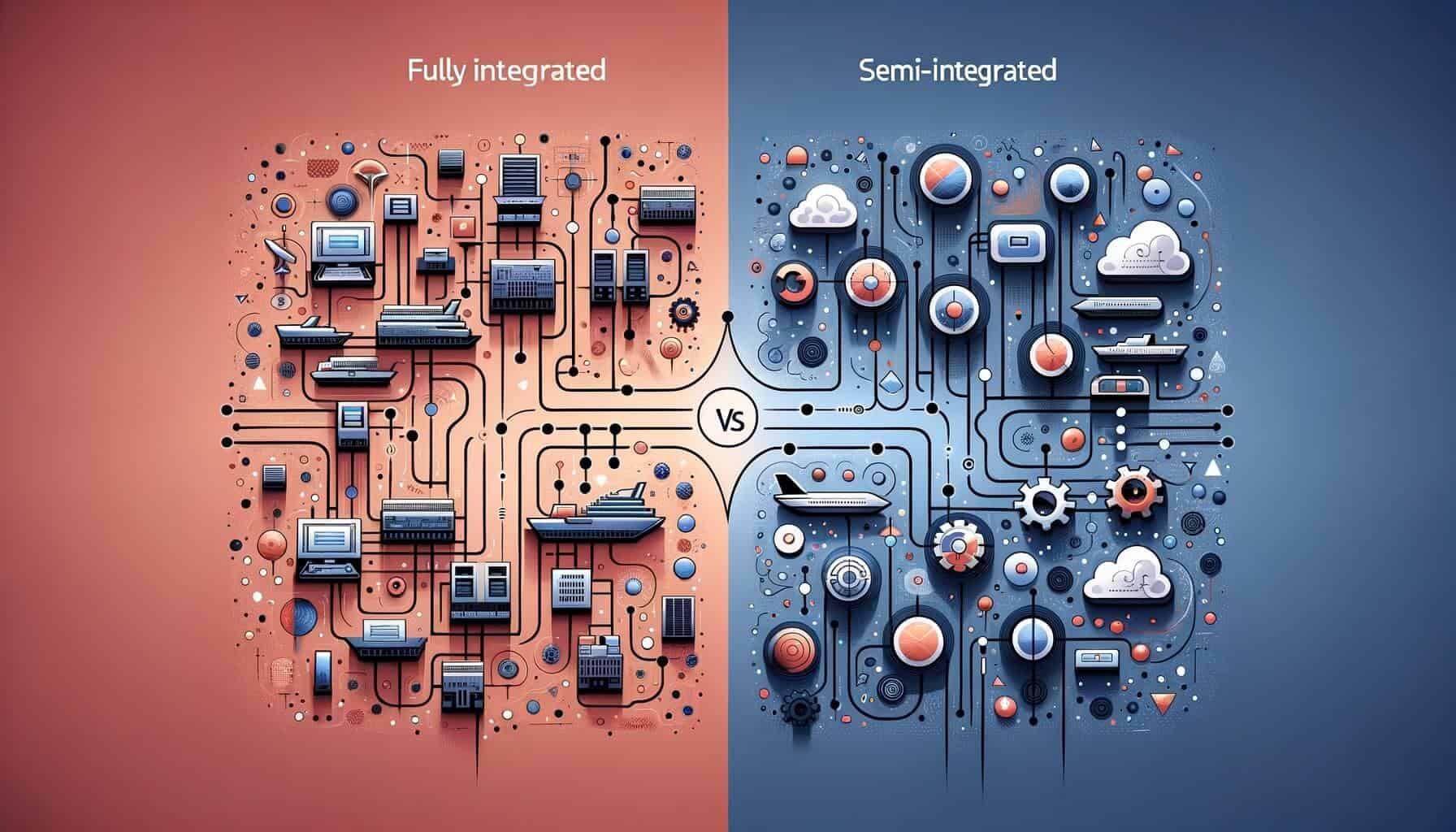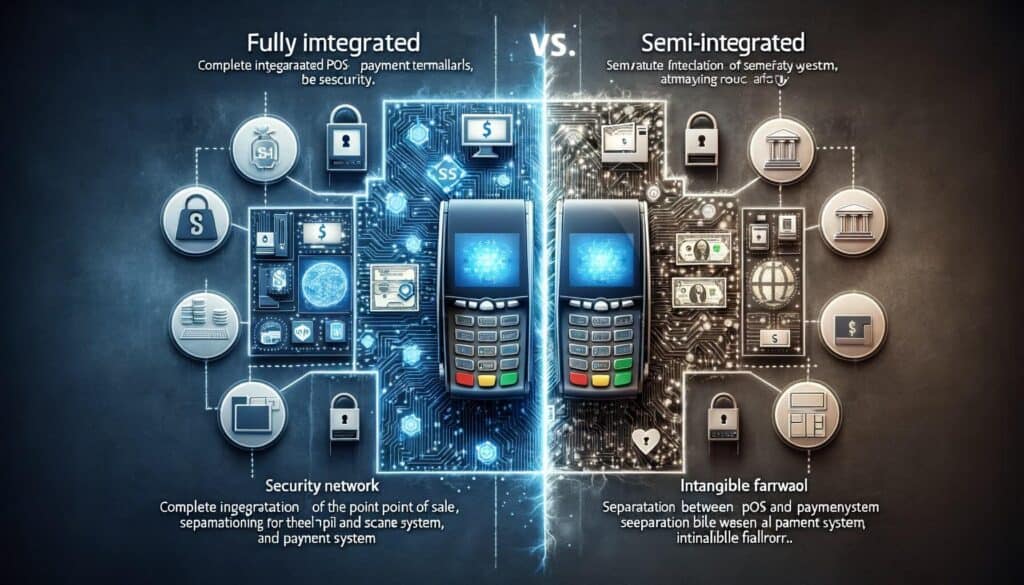
By Catharine Proctor February 24, 2025
In today’s digital age, payment processing has become an integral part of businesses across various industries. With the rise of electronic payments, it is crucial for businesses to have efficient and secure payment systems in place. Two popular options for businesses are fully integrated terminals and semi-integrated terminals. These terminals play a vital role in facilitating seamless transactions and ensuring a smooth customer experience.
In this article, we will delve into the differences between fully integrated terminals and semi-integrated terminals, exploring their features, benefits, limitations, security considerations, integration process, cost analysis, and user experience.
Exploring Fully Integrated Terminals: Features, Benefits, and Limitations

Fully integrated terminals are payment processing solutions that are seamlessly integrated into a business’s point-of-sale (POS) system. These terminals are designed to work in conjunction with the business’s software, allowing for a streamlined and efficient payment process. One of the key features of fully integrated terminals is their ability to communicate directly with the business’s POS system, eliminating the need for manual data entry and reducing the risk of errors.
One of the major benefits of fully integrated terminals is the enhanced efficiency they offer. By eliminating the need for manual data entry, businesses can save time and reduce the chances of human error. Additionally, fully integrated terminals provide real-time reporting and analytics, allowing businesses to gain valuable insights into their sales and customer behavior.
However, fully integrated terminals also have their limitations. One limitation is the potential for compatibility issues with certain POS systems. Not all POS systems are compatible with fully integrated terminals, which can limit the options available to businesses. Additionally, fully integrated terminals may require more upfront investment compared to other payment processing solutions.
Unveiling Semi-Integrated Terminals: Features, Benefits, and Limitations

Semi-integrated terminals, on the other hand, are payment processing solutions that are partially integrated into a business’s POS system. Unlike fully integrated terminals, semi-integrated terminals do not communicate directly with the POS system. Instead, they rely on a middleware or gateway to facilitate the communication between the terminal and the POS system.
One of the key features of semi-integrated terminals is their flexibility. Since they do not require direct integration with the POS system, businesses have more options when it comes to choosing a payment processing solution. This flexibility allows businesses to easily switch between different payment processors without having to make significant changes to their POS system.
Another benefit of semi-integrated terminals is their enhanced security. By relying on a middleware or gateway, sensitive payment data is kept separate from the POS system, reducing the risk of data breaches. Additionally, semi-integrated terminals often come with built-in security features such as encryption and tokenization, further enhancing the security of transactions.
However, semi-integrated terminals also have their limitations. One limitation is the potential for increased complexity. Since semi-integrated terminals rely on a middleware or gateway, businesses may need to invest additional time and resources in setting up and maintaining the integration. Additionally, the reliance on a middleware or gateway introduces an additional point of failure, which can impact the reliability of the payment process.
Key Differences between Fully Integrated and Semi-Integrated Terminals

While both fully integrated terminals and semi-integrated terminals serve the purpose of facilitating payment processing, there are key differences between the two. One of the main differences lies in the level of integration with the POS system.
Fully integrated terminals are seamlessly integrated into the POS system, allowing for direct communication and real-time data exchange. On the other hand, semi-integrated terminals rely on a middleware or gateway to facilitate the communication between the terminal and the POS system.
Another difference between fully integrated terminals and semi-integrated terminals is the level of flexibility they offer. Fully integrated terminals are often limited to specific POS systems, which can restrict the options available to businesses. In contrast, semi-integrated terminals offer more flexibility, allowing businesses to choose from a wider range of payment processors without having to make significant changes to their POS system.
Security Considerations: Comparing Fully Integrated and Semi-Integrated Terminals

When it comes to payment processing, security is of utmost importance. Both fully integrated terminals and semi-integrated terminals have their own security considerations. Fully integrated terminals, by virtue of their direct integration with the POS system, can provide a higher level of security. Since the payment data is transmitted directly from the terminal to the POS system, there is less risk of data breaches or unauthorized access.
Semi-integrated terminals, on the other hand, rely on a middleware or gateway to facilitate the communication between the terminal and the POS system. While this introduces an additional layer of complexity, it also provides an opportunity to enhance security. Many semi-integrated terminals come with built-in security features such as encryption and tokenization, which can help protect sensitive payment data.
Integration Process: How Fully Integrated and Semi-Integrated Terminals Connect with Payment Systems
The integration process for fully integrated terminals and semi-integrated terminals differs significantly. Fully integrated terminals require direct integration with the POS system, which often involves working closely with the POS system provider. This integration process can be complex and time-consuming, requiring businesses to invest resources in ensuring compatibility and seamless communication between the terminal and the POS system.
On the other hand, the integration process for semi-integrated terminals is typically less complex. Since semi-integrated terminals rely on a middleware or gateway, businesses can choose from a range of providers that offer pre-built integrations with popular POS systems. This pre-built integration simplifies the setup process and reduces the time and effort required to get the payment processing solution up and running.
Cost Analysis: Comparing the Financial Implications of Fully Integrated and Semi-Integrated Terminals
When considering fully integrated terminals and semi-integrated terminals, it is important to analyze the financial implications of each option. Fully integrated terminals often require a higher upfront investment compared to semi-integrated terminals. The direct integration with the POS system can involve additional hardware and software costs, as well as the cost of professional services for setup and customization.
Semi-integrated terminals, on the other hand, offer a more cost-effective solution. Since they do not require direct integration with the POS system, businesses can avoid the upfront costs associated with fully integrated terminals. Additionally, the flexibility of semi-integrated terminals allows businesses to choose from a range of payment processors, giving them the opportunity to find the most cost-effective solution for their needs.
User Experience: Evaluating the Impact of Fully Integrated and Semi-Integrated Terminals on Customers
The user experience is a crucial aspect of any payment processing solution. Both fully integrated terminals and semi-integrated terminals can have an impact on the customer experience. Fully integrated terminals, with their seamless integration into the POS system, offer a more streamlined and efficient payment process. Customers can enjoy a smooth checkout experience, with minimal wait times and reduced chances of errors.
Semi-integrated terminals, while not directly integrated with the POS system, can still provide a positive user experience. The flexibility of semi-integrated terminals allows businesses to choose payment processors that offer user-friendly interfaces and features such as contactless payments and mobile wallets. By providing a variety of payment options, businesses can cater to the preferences of their customers and enhance their overall experience.
Frequently Asked Questions (FAQs)
Q1. What is the main difference between fully integrated terminals and semi-integrated terminals?
Answer: The main difference lies in the level of integration with the POS system. Fully integrated terminals are seamlessly integrated into the POS system, allowing for direct communication and real-time data exchange. Semi-integrated terminals rely on a middleware or gateway to facilitate the communication between the terminal and the POS system.
Q2. Which type of terminal offers more flexibility?
Answer: Semi-integrated terminals offer more flexibility compared to fully integrated terminals. Since they do not require direct integration with the POS system, businesses have more options when it comes to choosing a payment processing solution.
Q3. Are fully integrated terminals more secure than semi-integrated terminals?
Answer: Fully integrated terminals, by virtue of their direct integration with the POS system, can provide a higher level of security. However, semi-integrated terminals often come with built-in security features such as encryption and tokenization, which can help protect sensitive payment data.
Q4. What is the integration process for fully integrated terminals?
Answer: The integration process for fully integrated terminals involves direct integration with the POS system. This process can be complex and time-consuming, requiring businesses to work closely with the POS system provider to ensure compatibility and seamless communication.
Q5. Are fully integrated terminals more expensive than semi-integrated terminals?
Answer: Fully integrated terminals often require a higher upfront investment compared to semi-integrated terminals. The direct integration with the POS system can involve additional hardware and software costs, as well as the cost of professional services for setup and customization.
Conclusion
In conclusion, fully integrated terminals and semi-integrated terminals are two popular options for businesses looking to streamline their payment processing. While fully integrated terminals offer seamless integration with the POS system and enhanced efficiency, they may require a higher upfront investment and have compatibility limitations. On the other hand, semi-integrated terminals provide flexibility, enhanced security, and a more cost-effective solution.
The choice between fully integrated terminals and semi-integrated terminals ultimately depends on the specific needs and priorities of the business. By carefully considering the features, benefits, limitations, security considerations, integration process, cost analysis, and user experience of each option, businesses can make an informed decision that aligns with their goals and objectives.